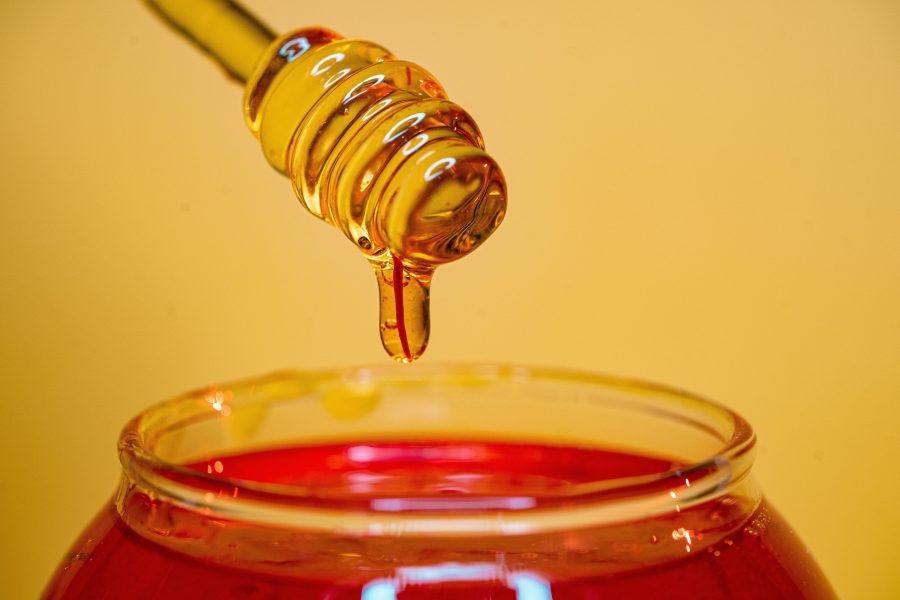Project news Label on your honey jar correctly

As a beekeeper, it is important to pay attention to correct labeling, among other things for traceability in the food chain. The Federal Food Agency (FASFC) attaches great importance to it during inspections and it has also been checked in the honey analyses of the Strategic Plan Beekeeping since 1998. Yet a high percentage of honey jars still contain an illegal label. In 2023, ILVO found errors in 29% of the samples brought in, 38% of the resampled samples and even 60% of the samples purchased by ILVO itself. At the start of the honey analyses of production year 2024, ILVO will therefore reiterate all rules around labeling.
The top 5 errors on honey labels are failure to indicate country of origin, presence of unauthorized information and failure to mention HONEY, name and address of beekeeper or net weight.
Mandatory information
Volgende informatie moet op het etiket in correcte bewoording vermeld worden:
- The sales designation 'HONING' or 'HONIG'
- The name and full address of the producer/importer
- The net weight The net weight must be indicated in the same field of vision as the trade name. If the ℮ mark is used, the rules regarding its use must be respected and the regulations regarding the minimum font size must be observed.(Het ℮-merkteken: aanduiding van de hoeveelheid van een voorverpakt product - Your Europe (europa.eu))
- The date of minimum shelf life (maximum 2 years from date of potting, depending on moisture content). There is no requirement that the minimum shelf life be effectively a full 2 years on the label. On the contrary, as stated on the FASFC website, it depends on the moisture content. For honey with an increased moisture content, a shorter period is advised. As a guideline, the following advice can be given: moisture content <17%: 2 years; moisture content 17-18%: 18 months; moisture content 18-19%: 1 year; moisture content 19-20%: 6 months.
- A lot number; if the date of minimum shelf life consists of day/month/year, this can also serve as the lot number
- The country of origin where the honey was harvested. Currently, country of origin labeling is only mandatory if the honey comes from one country. In the future, country of origin labeling will also be required for mixtures of honey (Directive (EU) 2024/1438 amending Directive 2001/110/EC).
- The indication of appropriate storage and use conditions if the producer finds it useful. Recommendation: 'Keep dry, dark and at a temperature below 15°C'. Since honey with an increased moisture content is at risk of fermentation, it is considered that storage conditions should definitely be mentioned for honey with a moisture content above 19%, or if it is honeydew honey, starting at 18% moisture. As mentioned in the Gids voor goede Bijenteeltpraktijken (p. 52) such honey should be stored at a temperature below 11°C.
Allowed information
Additional information on composition and nutritional value may appear on the label, but it is not mandatory and is subject to some requirements:
According to Regulation (EU) 1169/2011, for honey the indication of the list of ingredients (honey = single ingredient food) or the nutritional value is not mandatory. However, the indication is allowed if the requirements mentioned in this Regulation are met. The information may not be misleading, ambiguous or confusing for the consumer and must be based on relevant scientific data.Unauthorized information
The following information is not allowed on the label (some examples):
- “100% honey, bee honey, without additives, 100% pure, naturally pure, pure” (cfr. Sectorguide Beekeeping p. 50). By definition, honey is prepared by bees from flower nectar or honeydew. Nothing may be added or extracted to honey; therefore, honey must always be 100% pure. Such additional information on the label is considered misleading.
- Phrases such as “100% artisanal or artisanal honey” (cfr. Beekeeping Sector Guide p. 50). The term artisanal may only be used if the guidelines issued by FPS Economy on 5/10/2017 are fully complied with. In doing so, the product must be clearly distinguished from a conventional product. “Artisanal” presupposes clear transformation steps. The initial product honey is thereby in danger of being modified in terms of the substantive natural legal parameters. Therefore, the term “artisanal” or “artisanal” may not be applied to honey.
- A designation such as “cold extracted.” After all, honey is always cold extracted.
- Health claims are not allowed if they are not scientifically substantiated (Regulation (EC) 1924/2006).
This information can also be found in theGids voor goede Bijenteeltpraktijken and on the FASFC website.
More info on honey analysis for Flemish beekeepers:https://ilvo.vlaanderen.be/nl/dossiers/honinganalyses
Implemented within the framework of the Strategic Plan for Beekeeping (formerly known as The Flemish Beekeeping Program)

Contact
Katrien Broekaert, katrien.broekaert@ilvo.vlaanderen.be
Sigrid Ooghe, sigrid.ooghe@ilvo.vlaanderen.be
Wim Reybroeck, wim.reybroeck@ilvo.vlaanderen.be